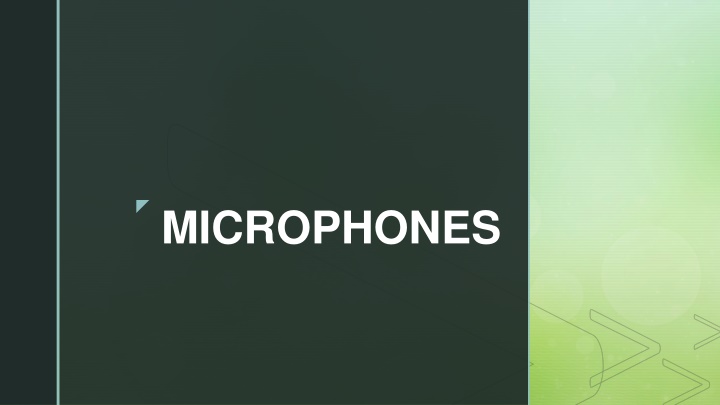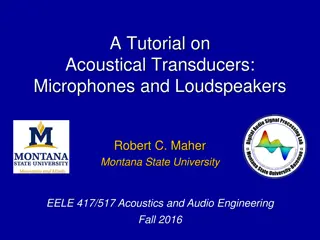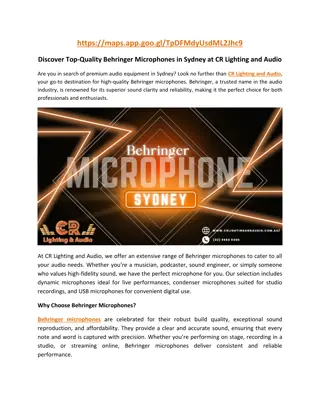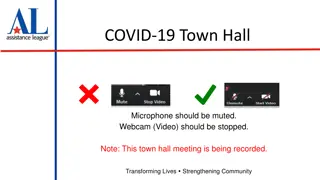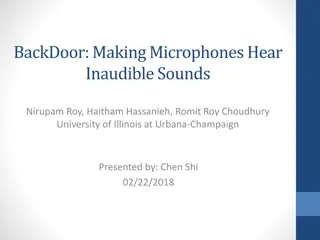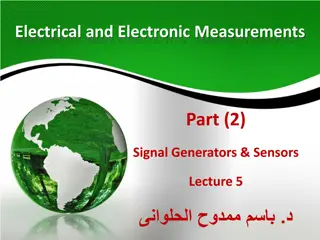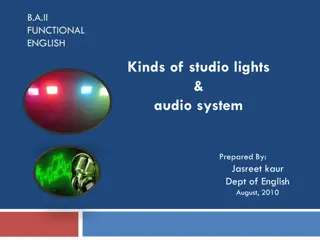Exploring Microphones: Types and Characteristics
In the world of audio recording, understanding the different types of microphones and their characteristics is crucial for capturing high-quality sound. Microphones can be categorized based on their transducer/element type, directional characteristics, and frequency response. The three major transducer types are dynamic, condenser, and ribbon, each with its own strengths and ideal applications. Additionally, the directional characteristic of a microphone, such as cardioid, bi-directional, or omnidirectional, impacts how it picks up sound and isolates from the environment. By exploring these categories, you can choose the right microphone for your recording needs.
Uploaded on Apr 12, 2025 | 3 Views
Download Presentation

Please find below an Image/Link to download the presentation.
The content on the website is provided AS IS for your information and personal use only. It may not be sold, licensed, or shared on other websites without obtaining consent from the author.If you encounter any issues during the download, it is possible that the publisher has removed the file from their server.
You are allowed to download the files provided on this website for personal or commercial use, subject to the condition that they are used lawfully. All files are the property of their respective owners.
The content on the website is provided AS IS for your information and personal use only. It may not be sold, licensed, or shared on other websites without obtaining consent from the author.
E N D
Presentation Transcript
THREE MAJOR CATEGORIES TO CONSIDER 1. Transducer/element type 2. Directional characteristics 3. Frequency response
DYNAMIC Rugged, excellent for live sound! Can handle loud sources Great for close miking SM 57, Sennheiser 421, EVRE 20
CONDENSER Much more fragile Most have a DB pad to help deal with loud sources Great at capturing details Require external power: phantom power +48V AKG 414, SM 81, at 4050
RIBBON Can be fragile Rarely used for outdoor applications, very sensitive to wind Great for digital recording Typically color the sound the most out of the three transducers Royer 122, AEA84, Cascade Fat Head
DIRECTIONAL CHARACTERISTIC Typically referred to as pickup pattern or polar pattern Helps determine how isolated a recorded sound is and how much environment is present in the sound
CARDIOID Heart-shaped, sometimes referred to as uni-directional Picks up sound from front/side of mic, rejects sound from back Other types of cardioid patterns: supercardioid, hypercardioid Most common pickup pattern: SM57, SM58, Sennheiser 421 Exhibits proximity effect, a low-end boost of 100HZ when you get closer to the mic Avoid proximity effect by using a low cut, backing up the mic, or using an omnidirectional pickup pattern
BI-DIRECTIONAL Also known as figure 8 Picks up sound from front and back of mic, rejects sound from the sides Common pickup pattern with ribbon mics
OMNIDIRECTIONAL Picks up sound equally from all directions Does not exhibit proximity effect Tends to have a flatter frequency response Likely to have more environment and bleed-over in the sound
FREQUENCY RESPONSE Refers to how well a particular mic responds to all the frequencies that strike it Linear frequency response = flat. What goes in the mic is what comes out. No change in the tone of the source Non-linear frequency response = color. What goes in the mic comes out differently. Source tone is affected for better or worse
